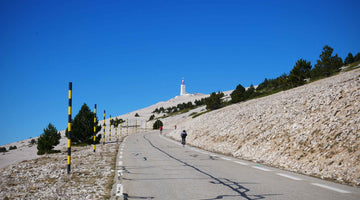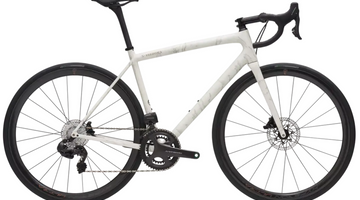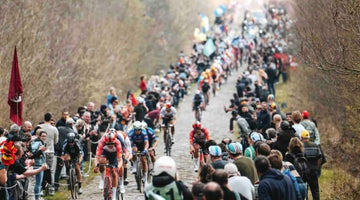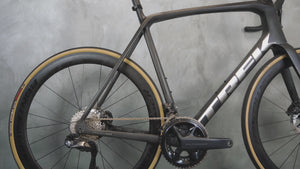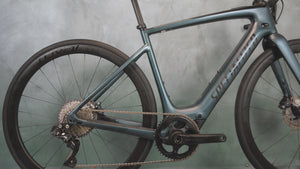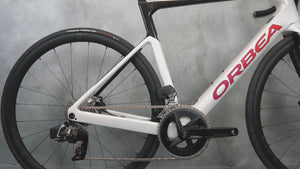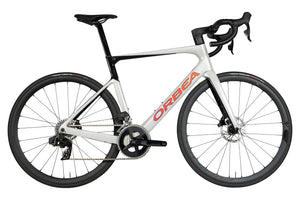Road bike brakes: beginner's guide
In this Article
- 1. What are the characteristics of road bike brakes?
- 2. What are the different types of road bike brakes?
- 3. Disk brakes
- 4. Are the road bike brake pads universal?
- 5. How to define the type of brake I need?
- 6. Do I need to use the front or back brake?
- 7. What types of accessories do I need?
- 8. When should I change my brakes?
- 9. CONCLUSION
Posted on September 6, 2021
The brakes are one of the most important elements of the road bike! Cyclists trust well maintained and perfectly functional brakes to stop when they wish, to help them control their speed when they negotiate the turns and avoid obstacles, all securely.
Disc brakes, mechanical brakes, brakes on rim, hydraulic brakes, V brakes, brakes, cantilever brakes - they are numerous!
The Cyclist House today gives you all the characteristics of these different types of brakes & answers all the questions you could ask you! But if you have others, do not hesitate to ask them on Facebook Where Instagram.
What are the characteristics of road bike brakes?
Whatever the type of brake you have on your road bike, it is designed to help you control your speed in all conditions!
All road bike brakes work just in the same way and have the same characteristics. The brake levers mounted on the handlebars operate cables or hydraulic lines, which are connected to the brake caliper on the wheel or brake disc. Press the brake levers with the appropriate force and activate the brake caliper, which applies the brake pads on the braking surface (either the rim on a brake bike on a rim or the disc on a bike to brake Disk), and you slow down or stop completely.
It's rather easy!

What are the different types of road bike brakes?
There are two brake groups in the world: the brakes on rim and disc brakes. The brakes on rim are those that traditionally put on road bikes. But, for about ten years, the disc brakes have left the mountain bike universe to join the road bikes. The frame brackets and the passage of the cables are very different for each system. If your bike is designed for rim brakes, you can not convert it into disc brakes and vice versa.
Disk brakes
Disk brakes are very popular because they are powerful and reliable. But they have their advantages and disadvantages. Although they have greater braking power on wetland and they are renowned for their high modulation and regularity, people looking for great lightness in their bike say they are too heavy. But the discs become more and lighter, and their success continues to grow!

Benefits
- Impressive braking power on wetland
- COHERING BRAKING AND MODULATION
- Less hand fatigue at braking
- Increases the longevity of the wheel (the braking surface is not on the rim)
- Not affected by the deregulation of the wheel
Disadvantages
- Weight
- Price
- The maintenance can be complicated (especially with hydraulic brakes).
Disk brakes exist in two versions: mechanical and hydraulic.
Disk brakes: mechanical

Note the braided steel cable at the brake caliper. The cable pulls the arm that operates the mechanical disk brake.
Mechanical disc brakes use a traditional braided steel cable to squeeze the brake surface. That's why they are also called: "Cable Activated Brakes". They are more advantageous price level. If you want disc brakes but you have a limited budget, these are a very good choice.
The disadvantage is that they are heavier and require greater braking force, you will have more rotor friction problems and cables are subject to wear.
Disk brakes: hydraulic

On some road bikes, we hardly see the cables of the hydraulic brakes.
We recognize the brakes at Hydraulic disk by their sheath. It is a fully sealed hydraulic pipe, which means that it is a pipe and not a cable. When tightening your brakes, the compression of the hydraulic brake fluid inside the pipe activates the brake caliper and platelets to slow down or stop.
The maintenance of hydraulic brakes can be a little more complicated. You will periodically purge the system to remove air bubbles and refresh the liquid. This operation is not simple for amateur mechanics and requires special tools, but it is always interesting to acquire new skills.
The gear lever used on the hydraulic disc brakes actually the most expensive option, but the sensitivity is higher on this type of brake (more power, less force required).
Rims brakes
All wheels have rims and in a braking system on rim, it is at this point that the braking force is applied. When you press the brake lever, the brake pad is compressed on the brake track of the rim, which makes it possible to slow down your speed. Road bikes, BMX bicycles, tourist and city bicycles or Cyclocross bicycles, all have brakes on rim. Road bike riders prefer this type of brake but today, only a handful of professionals still use them.
Benefits
- Lighter than the disc
- Simple and easy mechanics to maintain
- More aerodynamic
Disadvantages
- Less reactive than the disks
- The brake pads wear out more quickly
- Limits the release of tires
- Less good on wet ground
- Wear of the rim faster than that of the disc (but your wheels will last long!)
While the disc brakes exist only in two versions, you will find several types of brake systems on rim, each with its peculiarities and advantages.
Calcher brakes

A conventional bike usually has a classic caliper brake configuration.
The mechanism operated by the brake lever is named "the stirrup". But it is also a type of braking system on rim and also the most common system. A caliper braking system is a U-shaped monobloc unit mounted on the frame or fork by a single fixing hole. The unique pivot brackets and double-pivot stirrups are also distinguished, which refer to where the stirrups rotate in the mechanism when activated. The double pivotal stirrups, more powerful, are the most common on new bikes.
Cantilevers brakes

Cantilever brakes offer better release of mud and more power.
Cantilever type brakes are found on cross bikes, but because of the superiority of disks in the mud, cross-cantilever cross bicycles are rare. The cantilever system with central traction consists of two separate brake arms mounted on each side of the rim. Tighten your brake levers and the cable is tense via a central traction cable to pull each brake arm at the same time, pushing the pads against the rim. The cantilevers offer two considerable advantages: a better release of tires and mud and a very good braking power.
V-brakes
V-brakes are a subcategory of cantilever brakes, they are found on city bikes, tourism bikes and hybrid bicycles. Like the cantilever brakes, the V brakes are mounted via bosses on the frame, at the fork and the hatbon, and have two individual brake arms. But unlike cantilever, they are direct traction and not at central traction. Which means that when you press the brake lever, an arm is pulled toward the rim, while the other is pushed to the rim. V brakes have good braking power in town and plenty of room for mudguards.
Are the road bike brake pads universal?
The answer is no. Shimano brake pads do not work in an SRAM system, for example, and vice versa. As with any type of Mix-and-Match McGyverying that you might consider - and this also applies to components such as brake levers - the best is to stay in the same family. It means Shimano with Shimano, Campagnolo with Campagnolo, Sram with Sram, etc ...
How to define the type of brake I need?
First of all, you have to determine where you practice most often. What are the weather, if it often rains or not. How often do you roll? Do you practice road cycling or Gravel bike? Ask yourself the right questions, they will determine your preferences for wheels or disc brakes. But, attention, bicycles with brakes on wheels are likely to disappear soon ... too, your budget can determine your choice. If the hydraulic disc brakes are more expensive than the mechanical brakes, the offers of the different brands - SRAM Force compared to the TRP HY / RD disc brakes, for example - will also determine what your portfolio can support. Another factor to take into account (whether you choose a brake on rim or disc, mechanical or hydraulic) will be your level of knowledge in mechanics, some systems are easier to maintain than others.

Brakes on wheels or disc brakes? The first is simpler and lighter, but the second is modern and more powerful.
Do I need to use the front or back brake?
The use of the front or rear brake depends on the situation in which you are. Remember that your front brake has the highest braking power, so it is not recommended to tighten it sharply without using the rear brake, you may pass over your bike. Controlled braking is the key to a soft and smooth speed control or speed control, and is obtained by tightening both brakes together. The rear brake is ideal for regulating the speed when you go a little too fast, that you borrow routes full of hen nests or that you are in a situation of bad traction.
What types of accessories do I need?
If you are a little mechanic in the soul, your toolbox for the brakes will have to contain:
- Spare pads
- Additional cables
- A purge kit for your disc brakes.
Note that the purge kits are specific to each brand, so the Shimano purge tools will not work with SRAM, for example.
Also, you will need a multifunctional tool to adjust the stirrups on the road, and your fingers to turn the barrel fitters on your cables to prevent the brakes from rub or tightening if your cables have stretched.
When should I change my brakes?
There are 3 ways to determine if your brakes are worn and therefore to change:
- First, by your feeling while driving. If you have the sensation that the brake efficiency has decreased or requires more force to function properly, this can be a sign of wear of the brake pads.
- Secondly, paying attention to noise. The discs are notorious indicators of platelet wear (and they are also very noisy in case of contamination of the wafer). They even scream by dry weather if they are at the end of life.
- And thirdly, looking at the platelets. Check the wear indicators of your rim brake pads, which are usually printed on the platelet side. The control is more delicate on a disc brake bike: you will need to remove the wheel from the rim, remove the pads and measure the platelet material with a caliper. In general, you want at least 3 mm of material.
At The Cyclist House, we advise you to pay attention to the wear of your disk brake pads. It is much cheaper to replace only platelets rather than replacing platelets and disks. So be careful when you hear a metal noise against the metal (it is the support plate of the brake pad that squeaks on the disc).
For hydraulic disc brakes, they are to purge when they become spongy or when you have to pull the brake lever almost to the bar.
CONCLUSION
You will understand it, the brakes are very important elements on a bike, you have to choose it because they can save you life and also avoid you a lot of falls! It is important to trust them and in their operation. It also makes it possible to take a lot more pleasure to roll because you will be master of the situation and you will be able to take the turns with confidence, some are the conditions. As a cyclist, you must decide yourself from the type of brakes you prefer and adapt your choice to the driving conditions, the surfaces and, of course, to your budget.
Good road !













